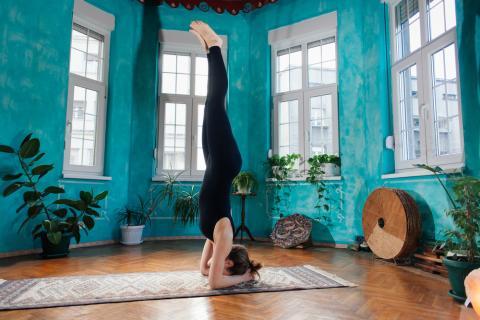
As a practicing yogi, I full-heartedly enjoy feeling into every yoga asana (position) from day to day and moment to moment because I know that with every asana I practice, my positive attitude toward mindful alignment offers me an opportunity to reconnect with my body, mind and spirit. As a whole, all yoga positions offer the practitioner re-alignment with their spine, while improving cardiovascular and respiratory health, weight loss and strength building -- granted the asanas are conducted with proper form. However, some yoga positions stand out to me more than others because their benefits are so immediate and immense! One of those asanas is the headstand, also known as “Shirshasana” in Sanskrit. The benefits of the Shirshasana inverted yoga pose are maximized over time as the placement of your heart above your head rejuvenates you in the following ways:
- Calms Your Brain: The Shirshasana speeds up the circulation of blood to your brain, and this increase in oxygenated blood induces a slight feeling of euphoria and wellbeing after you release from the position. For people like me who struggle with anxiety and depression, headstands may be just the position to help combat your fluctuations in mood and improve your mental health.
- Improves Your Digestion: The Shirshasana increases the heat in your digestive tract, cleansing your intestines by reversing the pull of gravity and releasing any congested blood that may be in your colon.
- Gives You a Face Lift & Clearer Complexion: By utilizing gravity during this inverted position, you are able to flush fresh nutrients and oxygenated blood to your face, giving you a kind of internal “face lift.” As your skin hangs in the opposite direction, your circulatory system becomes more effective at moving out other waste materials associated with the formation of wrinkles, pimples and blemishes.
- Stimulates Your Pituitary and Hypothalamus Glands: Headstands stimulate your pituitary gland and hypothalamus glands which are responsible for releasing endorphins, the body’s happy hormones, as well as regulating all other glands in the body by removing toxins from our body.
- Promotes Your Hair Growth: That’s right, headstands aid your hair to grow by sending oxygenated blood and nutrients to your scalp, promoting the growth of hair follicles.
A Beginner’s Guide to the Supported Headstand
To begin warming up to your Shirshasana position, I suggest moving into less challenging asanas such as the downward dog or dolphin pose. These are great exercises to prepare the body for the supported headstand by building heat and strength in your upper body and abdomen before learning to move into the full expression of the supported headstand.
When you’re ready to begin the supported headstand, lace your fingers together with your forearms placed perpendicular on your floor or mat with your elbows shoulder width apart. Then, begin to set the crown of your head on the floor and press the bases of your palms together while you gently move the back of your head into your clasped hands. Inhale deeply and then lift your knees off the floor and carefully walk your feet closer to your elbows with your heels elevated, activating your top thighs to form a “V.” Exhale and lift your feet away from the floor. Take both feet up at the same time, even if you have to bend a knee and firm your tailbone in line with your pelvis so that it is aligned over the crown of your head. For beginners, I suggest you maintain the pose for just 30 seconds until you get to know your body in this pose. As you gain understanding and confidence, you may want to increase your duration up to 1-5 minutes, depending on your comfort level and expertise. This headstand tutorial on YouTube by YogaWithAdriene, is a great introduction to the position -- and best of all, it’s free!
Disclaimer
This position is powerfully beneficial if practiced in proper alignment, however, it can be very difficult to master with many pitfalls along the way if it is not, including strained necks and other injuries. Therefore, I strongly encourage anyone who might be interested in trying this pose, especially if for the first time, to consult their physician before practicing the Shirshasana.








